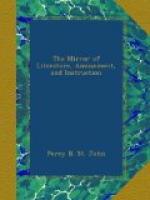ZOOLOGICAL GARDENS, REGENTS’S PARK.
[Illustration: Emu Enclosure]
[Illustration: Pelican Enclosure]
[Illustration: Aviary for Small Birds]
Our strolls to this scene of intellectual amusement, (or “the gardens with a long name,” as Lord Mulgrave’s new heroine naively calls them,) are neither few nor far between. The acquaintance is of some standing, since The Mirror was the first journal that contained any pictorial representation of these Gardens, or any connected notice of the animals.[1] At that time the Society had not published their “List,” and our twopenny guide was common in the hands of visiters. We do not ask for the thanks of the Council in contributing to their annual receipts, now usually amounting to L10,000.: we were studying the interest of our readers, which uniformly brings its own reward. The first of the present illustrations is the Emu Enclosure, in the old Garden. Several broods of Emus have been reared by the Society at their Farm at Kingston Hill; and some of the year’s birds are usually exhibited here. Next is the Pelican Enclosure, containing a house of mimic rock-work, and a capacious tank of water, the favourite element of the Pelican. One pair in mature plumage, and a second pair, supposed to be the young of the same species, are exhibited. The third Cut is the Aviary for small and middle-sized birds, at the north-eastern corner of the Garden. Here are kept various British Birds, as the different species of Crows and Song Birds. The bamboo ornaments of the building are not, therefore, of the appropriate character that we so much admire elsewhere in the Gardens.
[1] The Literary Gazette first published the Ground Plan of the Zoological Gardens, from a lithograph circulated among the members, towards the close of the year 1827. In seeking to do ourselves justice, we must not forget others. Our first Engraving, a Bird’s Eye View of the Gardens from an original sketch, appeared in No. 330, of The Mirror, September 6, 1828.
[Illustration: “Happy Jerry”]
The individual with this felicitous soubriquet, was a specimen of the great Mandrill Baboon, in its adult state, the Papio Maimon of Geoffrey, and the Cynocephalus Maimon of Desmarest. It is a native of the Gold Coast and Guinea, in Africa, where whole droves of them often plunder the orchards and vineyards. Their colours are greyish brown, inclining to olive above; the cheeks are blue and furrowed, and the chin has a sharp-pointed orange beard; the nose grows red, especially towards the end, where it becomes of a bright scarlet. Such are, however, only the colours of the adult animal; the young differs materially, on which account it has been considered by naturalists as a distinct species.




